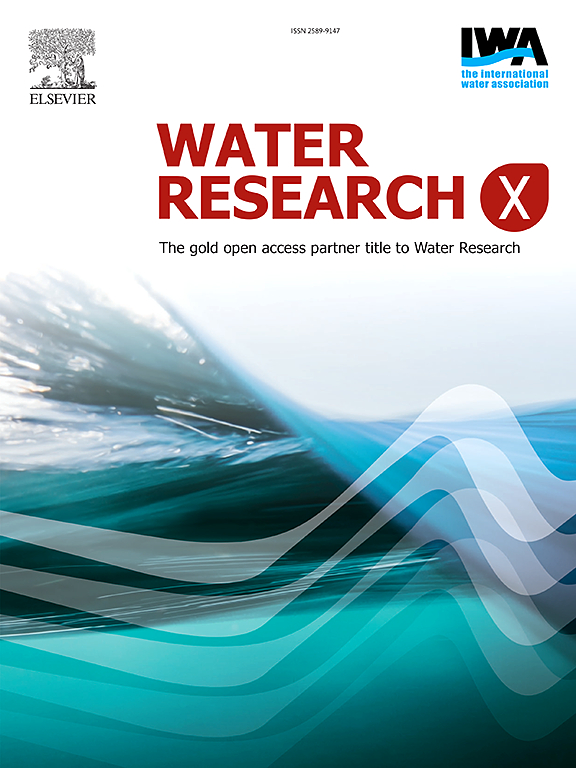通过综合边缘中心性和多准则脆弱性分析揭示水网中的关键管道
IF 7.2
2区 环境科学与生态学
Q1 ENGINEERING, ENVIRONMENTAL
引用次数: 0
摘要
配水网络(wdn)是关键的基础设施,必须可靠地供水,尽管组件老化和管道故障频繁。传统的脆弱性评估主要采用以节点为中心的观点,往往忽视了管道本身的关键作用。本研究提出了一种范式转换,将复杂网络理论与多准则分析相结合,建立以管道为中心的脆弱性评估框架。我们将管道视为基本的网络元素,并根据管道特性开发边缘中心性度量(ecm)。通过将管道长度、条件指数(CI)和故障概率(POF)纳入四个基本拓扑指标(边缘度、边缘邻域度、边缘之间度和边缘接近度),生成了16个不同的ecm。这些指标捕获了网络连接的重要性和物理退化风险。熵权法(EWM)客观地为每个指标分配权重,而理想解相似性排序优先技术(TOPSIS)将这些指标聚合成一个综合脆弱性指数(VI),对管道的临界程度进行排序。该框架在香港的淡水和咸水网络上进行了演示。结果表明,只有不到5%的管道被列为高度脆弱;值得注意的是,FW A区含有最高比例的高vi管道(≈14%),反映了其基础设施陈旧和人口密集。VI可以有效地识别关键管道,因为移除前0.4%最脆弱的管道会显著降低网络连通性(在一项关键性能指标中降低70%以上)。这些发现突出了以管道为中心的脆弱性方法的价值,并为优化城市水网的维护和修复策略提供了实用的见解。本文章由计算机程序翻译,如有差异,请以英文原文为准。
Revealing critical pipes in water networks through integrated edge centrality and multi-criteria vulnerability analysis
Water distribution networks (WDNs) are critical infrastructure that must reliably supply water despite aging components and frequent pipe failures. Traditional vulnerability assessments largely adopt a node-centric perspective, often overlooking the pivotal role of pipelines themselves. This study proposes a paradigm shift to a pipe-centric vulnerability assessment framework that integrates complex network theory with multi-criteria analysis. We treat pipes as fundamental network elements and develop edge centrality metrics (ECMs) tailored to pipe characteristics. Sixteen distinct ECMs are generated by incorporating pipe length, a condition index (CI), and probability of failure (POF) into four base topological metrics (edge degree, edge neighborhood degree, edge betweenness, edge closeness). These metrics capture both network connectivity importance and physical deterioration risk. The entropy weight method (EWM) objectively assigns weights to each metric, and the technique for order preference by similarity to ideal solution (TOPSIS) aggregates them into a composite vulnerability index (VI) that ranks pipe criticality. The framework is demonstrated on Hong Kong’s freshwater (FW) and saltwater (SW) networks. Results show that fewer than 5 % of pipes are classified as highly vulnerable; notably, FW Zone A contains the highest fraction of high-VI pipes (≈14 %), reflecting its older infrastructure and dense population. The VI effectively identifies critical pipes, as removing the top 0.4 % most vulnerable pipes dramatically drops network connectivity (over 70 % reduction in a key performance measure). These findings highlight the value of a pipe-centric vulnerability approach and offer practical insights for optimizing maintenance and rehabilitation strategies in urban water networks.
求助全文
通过发布文献求助,成功后即可免费获取论文全文。
去求助
来源期刊

Water Research X
Environmental Science-Water Science and Technology
CiteScore
12.30
自引率
1.30%
发文量
19
期刊介绍:
Water Research X is a sister journal of Water Research, which follows a Gold Open Access model. It focuses on publishing concise, letter-style research papers, visionary perspectives and editorials, as well as mini-reviews on emerging topics. The Journal invites contributions from researchers worldwide on various aspects of the science and technology related to the human impact on the water cycle, water quality, and its global management.
 求助内容:
求助内容: 应助结果提醒方式:
应助结果提醒方式:


